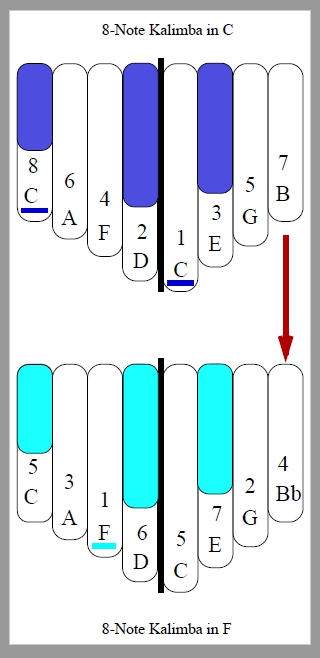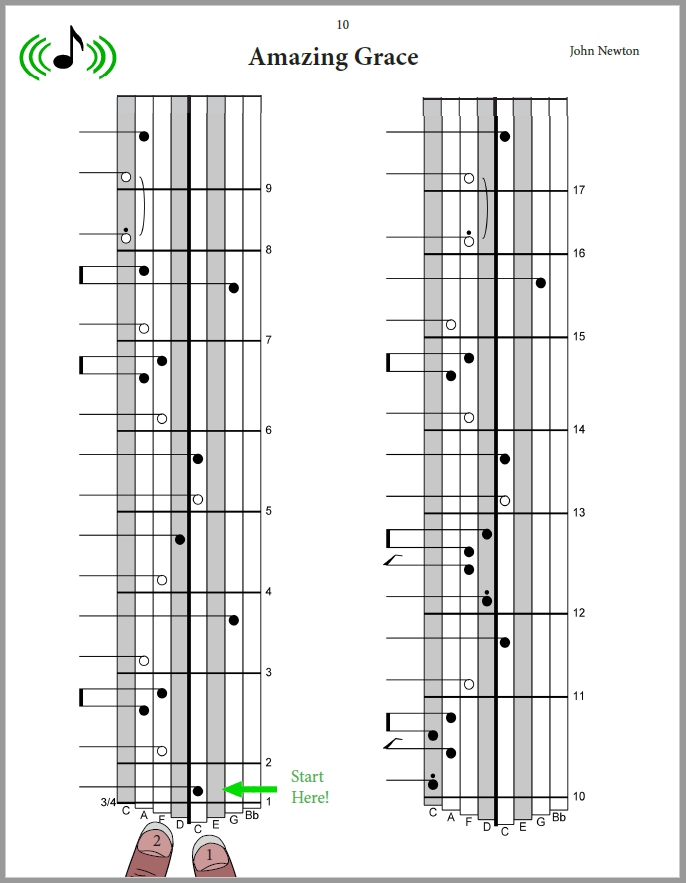
Use of this website constitutes acceptance of the Privacy Policy and User Agreement. Copyright © 2020 Kalimba Magic. All Rights Reserved.
If you have an 8-Note or a 10-Note kalimba, you may have learned “Joy to the World,” “Ba Ba Black Sheep,” and “Doe, a Deer” or various other simple songs. But what do you do next?
Typically, when someone masters a kalimba, they search for another kalimba challenge – usually a bigger or more exotic kalimba. However, I offer you another path, and it’s right in front of you! A very simple modification of your 8-Note or 10-Note kalimba will transform it into a new tuning, with a new repertoire – essentially providing you with the challenge of a new kalimba without having to acquire another one.
Just how do you accomplish this very simple transformation? I’ll show you! And once you have your “new” kalimba, it will be capable of playing all the songs in our newly published ebook 32 Songs for the 8-Note (or 10-Note) Kalimba. Also, now available as a hard copy book.
Here are the tuning charts for the most common 8-Note tuning (with the 10-Note charts below), and the one note that must be retuned – pulling out the B tine a few millimeters to tune it to B flat (or Bb), throwing the kalimba into the key of F.

This is musical judo at its best! One simple little retuning will flip the simple 8 (or 10)-Note kalimba into a whole new key (from C to F), turning it into a whole new instrument.
The typical tuning (C) for these kalimbas is where the low note and the high note are both C, the root note. Despite that, there are many, many songs that won’t fit on this instrument in this tuning. There are many songs that would like to go down below the “1” note, down to the “5” of the lower octave (that is, G). Clearly, tuning all those tines way down so that the low note is G would be a huge hassle (don’t try it).
But when you tune your kalimba’s “7” note, B, down a half step to Bb, this changes the root note to F. If F is the “1” note, then the C, or “5” note, will be on the longest tine. Playing the four longest tines from low to high gives you C, D, E, F (do it snappy and you get the theme song to “The Addams Family”). Going up from F, we have “1 2 3 4 5” – that is, we have half of the F scale above, and half of the F scale below.
Just to summarize: the simple retuning of B to Bb does not change any other notes, but it changes the way we think about the notes. The low note, C, is no longer home base. F is now home base, and the C note pushes us to that home.
We do not have the situation we had before, where we had two of the root notes and a full octave in between. As such, different songs are now available to this tuning.
Do you remember the ebook, Easy Christmas Carols for the 10-Note Kalimba? In that book, we had only 8 Christmas songs that you could do in the standard C tuning… but when we retune the B to Bb, that gives us 20 more Christmas carols. This leads us to believe that our F tuning here probably has more songs than you can do in the standard C tuning.
For reference’s sake, here is the tuning chart for the 10-Note kalimba – it is the same as the 8-Note, but with an extra note on the far right and the far left. And the way you change the 10-Note from C to F is exactly the same way we did it on the 8-Note:
Here is the Table of Contents of the new ebook, containing the songs you can play in F:

If you are familiar with our older downloads, this is half the the “66 Songs” for the 17-Note kalimba download. Let that sink in: with only 8 notes, you can do half of those songs you can do on the 17-Note kalimba… if you get your kalimba into the new tuning.
Now – for an example, I’ll show you where this book starts, with “Amazing Grace,” a simple “Level 1” song. This is a special example, though – you can play it without moving your B tine to Bb at all. Even though it is in the key of F (see the tablature below), this song is in the major pentatonic scale, meaning it has no 4th notes and no 7th notes. The 4th of F is Bb – meaning: a) you don’t actually have to retune your B tine to Bb to play “Amazing Grace” on your 8 (or 10)-Note kalimba, and b) go ahead and pick up your kalimba, and don’t even worry about retuning it – you can follow THIS song in your native tuning, and it will show you what it is like to play in the key of F:

Even though the first note of the song is C, that note springs us into the F. That is the V –> I classic chord progression, which describes our tendency for the “5” note to lead us home to the “1” note.
This page also shows us an important feature of this ebook – when you click on the sound icon in the upper-left corner (in the actual ebook, not this image of it) your web browser will download and play the MP3 sound file for the song on this page. At the very least, as you listen to the song, follow along with the notes of the tablature. As you get more experienced, you will, with the help of the tablature, be able to play kalimba along with the sound file.
As we have been talking about, each of the songs in this collection are also applicable to the 10-Note kalimba, by retuning your single B tine down to Bb.
And the music in this ebook? Not to toot my own horn too much, but they are spectacular, top-notch arrangements. As I am fond of saying, it’s worth getting this book just to hear the melodies and harmonies I have recorded, playing my own 8-Note kalimba. Sweet and beautiful. And even more so when you learn to play these songs yourself!
The media player below plays the song “Down By the Riverside” from this collection on an 8-Note kalimba tuned to F.


Sign up for our newsletter and free resources with your email address:
We pinky promise not to spam you and to only send good stuff.
 Assist Paul Tracey Rebuild His House in Pacific Palisades
Assist Paul Tracey Rebuild His House in Pacific Palisades 8-Note Spiral Kalimba Turned into a Student Karimba
8-Note Spiral Kalimba Turned into a Student Karimba Seek to Infuse Your Musical Moments With Beauty and Magic
Seek to Infuse Your Musical Moments With Beauty and MagicUse of this website constitutes acceptance of the Privacy Policy and User Agreement. Copyright © 2020 Kalimba Magic. All Rights Reserved.